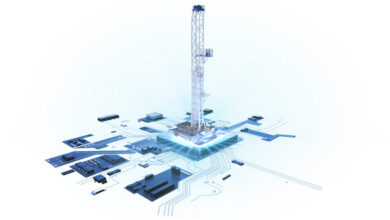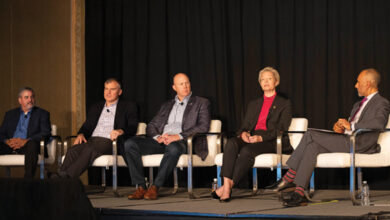Roles, scope of real-time operating centers, support technicians evolve within modern drilling ecosystem
Enhanced employee competencies can help to leverage capabilities of smart equipment, support facilities and custom software applications to realize efficiencies
Seth Robert, William Fiffick, Drew Davis and Robert Guillory, Canrig Drilling Technology; Joshua Myers, Nabors Drilling Solutions; Chakra Mandava, Nabors Corporate Services
The wider use of robotics, remote controls, real-time remote monitoring systems, artificial intelligence and other techniques are setting new standards of performance. The culmination of these engineering and technological efforts have yielded highly efficient, advanced-technology rigs. However, how should we develop and manage the support systems to leverage this modern drilling technology? Do we have the people, processes, tools and infrastructure needed to successfully apply these technologies?
This article reviews key elements necessary to support modern drilling, including real-time operations centers, competent field service technicians, custom software applications, new processes and drilling performance technology.
Challenges and solutions
The challenging business climate over the past few years has created an urgent need for drilling contractors to become more efficient. Concurrently, there is a need to demonstrate competitive advantages through better operational performance.
One component of a comprehensive solution is smart drilling equipment. Smart technology has advanced over the past few years, and automated alarms and various communication platforms can now alert key stakeholders when equipment is sensing conditions that could lead to failure.
Real-time operations centers are another component. A modern real-time operations center needs to be more than just a “call center” where issues are reported. They must have the ability to track the overall performance of the rig and understand maintenance conditions and status of equipment. An effective operations center is able to not only review issues but also to resolve them.
Finally, there are specialized custom software applications. Software applications today understand predictive as opposed to reactive analytics. These applications help to scale maintenance practices. They also gather sufficient information to suggest crucial maintenance by anticipating the threshold of possible failures.
Enhanced Competencies
Modern field service technicians effectively utilize information and capitalize on the efficiencies gained by real-time operations centers. Technicians become more efficient by accessing richer systems. By leveraging smart equipment, field service technicians are able to perform maintenance more quickly and effectively. This reduces the time needed for troubleshooting.
Equipment
Engineers and equipment designers are always looking for better ways to add value, whether through automation, software and programming or through advancements in equipment reliability, which is measured by tracking downtime.
Recent design enhancements provide the ability to monitor drilling equipment remotely through the internet of things (IoT). With modern technology, service companies can “remote in” to drilling equipment, look at current faults along with historian data, then quickly troubleshoot equipment issues from great distances.
Integrated sensors are also being used to let equipment report system alerts, which help to escalate issues prior to a point of failure. Not only does the system identify issues, but it can also escalate issues. System alerts can be programmed to report onsite and/or via email, phone calls or immediate dispatch. By automating the escalation processes, response times can be further reduced.
Real-Time Operations Center

As drilling operations have evolved, so have the concept and scope of the real-time operations center. In 2007, the “support center” became a central point where customers called to request technicians. Although issues were always captured in a database, efficiencies were not realized from incoming data.
As years passed, the scope of work expanded, as did the need for increased technical competencies of support technicians, who can now easily access the rig interface remotely. Having the ability to remotely see the rig interface enhances opportunities to immediately review operations data, driving even more opportunities to resolve issues remotely.
As equipment designs continue to improve, new levels of support opportunities have been identified. In 2007, the support center was staffed by up to 15 support technicians. By 2017, the real-time operations center had increased staffing to more than 75 support positions. Key performance indicators (KPIs) tracked include total issues reported, issues resolved remotely, response time and first-time resolution rates.
In the past, the support center was able to cover only a few product lines, while the support technician’s scope of work was limited to providing basic assistance to expedite dispatching field technicians. However, as remote communications improved, the skill set of support technicians expanded.
By 2010, the real-time operations center was being staffed by more than 44 support technicians, who were supporting up to five product lines. Within a few years after that, the support center was scaled to support more than 2,000 calls a month.
Through 2012, Canrig initiated a project to develop a Competency Assurance Management System (CAMS), which specifies the competencies necessary within a position. It created individual development plans for every technician, leading to short-term and long-term progression plans.
Within the first few years, the average competency level for technicians became a key leading indicator to overall improved customer satisfaction, further improving remote resolution rates.
The real-time operations center has become the central point of communication for field operations and maintenance. This key centralized group serves as an “expeditor” to a host of resources. For example, when a technician, whether local or remote rig support, needs technical documentation, the center can quickly access and distribute that information. Work instructions can be easily accessed as critical information for each job that is captured. The center can also access historical information, as well as maintenance histories for particular rigs and specific rig equipment.
In cases where a rig is down, the real-time operations center acts as the central point of communication. Through clearly defined processes and escalations, a major event coordinator is able to identify key stakeholders, capture critical documentation and distribute information.
This model to manage major events has improved communications across multiple groups. As a result of implementing the major event process, the percentage of downtime events lasting more than 12 hours has been significantly reduced.
Specialized Software Applications

Asset management software applications track the maintenance required for each piece of equipment. This allows equipment owners to view the entire life cycle of the asset. Further, the asset management applications track all unscheduled maintenance and equipment issues. Equipment work histories generated can be useful as a diagnostic tool for ongoing repair work and in determining failure modes for future prevention actions.
The service software applications track the entire life cycle of each service request. Asset data are derived from the asset management software applications, populating each service request. Throughout the life of the service request, the real-time operations technician uses this software to track service level agreements. The field service software applications capture critical KPI data. All appropriate information for the service request is stored in a central depository, accessible by appropriate stakeholders. Crucial data is always accessible via document tracking, improving close-out processes within each service request.
By gathering the pertinent information, the system understands customer requirements. Competency requirements are analyzed to determine which technicians are available and would be the best match to solve a particular issue. The field service system will understand the parts requirements, helping to locate the required parts. The field service system gathers this information, and, based on the scheduling module, offers recommendations for each service request. Automating logistic processes helps drive efficiencies, making the most of available resources. The field service system helps prioritize service requests, reducing response lags, improving utilization rates for technicians and reducing overall resolution times by having the right technicians doing the right jobs.
The real-time operations technician utilizes these integrated software applications to manage the customer service cycle as efficiently as possible. By employing these processes, KPIs in the following categories are improved: remote resolution, total call volumes, calls on hold time and agent availability.
Evolution of Field Service Technicians
In the recent past, it was customary to have two categories for field service technicians – electrical or mechanical. For electricians, troubleshooting older equipment meant taking voltage readings or using those readings to determine whether the electrical equipment had failed. For mechanics, the focus was on swapping broken parts, rebuilding and overhauling equipment.
However, as equipment designs advanced, so did technical requirements. By 2009, OEM training became mandatory to work on top drives, automated catwalks and automated floor wrenches. As drilling rig technology continued to advance, skilled technicians required further cross-training on multiple rig types.
By 2015, things were changing again, and technicians were expected to cross-train on multiple product lines. These increasing demands meant new skill sets were necessary.
The CAMS program specified the training required to keep pace with emerging industry requirements. It created career paths for field service technicians, identifying technical requirements to support their assessed training gaps. It also provides a personal training program focused on short-term and long-term goals.
With CAMS, the company formally measures technicians based on standard competency levels. The technicians are evaluated through trained assessors in the product line in which they are assessing.
Field Troubleshooting
Utilizing today’s technology with smart equipment, field service technicians can access current readings to better understand operating conditions. These systems help technicians understand what the current equipment status is through reading faults and conditions. Technicians can view this data using onsite computers or remotely by accessing the IoT.
Real-Time Operations Center
Onsite field service technicians requiring additional support can use the real-time operations center to gain additional technical assistance. Technicians can ask agents to help them access additional technical documentation, such as work instructions, product bulletins and schematics.
There are also times where technicians may need to escalate troubleshooting events. The real-time operations center can escalate service issues to master-level technicians, engineers and software programmers.
In cases where issues result in downtime, the center serves as the central command post. Major event coordinators capture the sequence of events and centralize communication by multiple resources through one point of contact, managing the workflows and escalating communication as required.
Organizational Structure
With smart drilling equipment, supporting roles are being enhanced. KPIs that prove the effectiveness of this model include improved downtime performance and reduced support costs. The company has developed an “ecosystem” synergizing smart drilling equipment improving overall performance. Available 24/7, the real-time operations center can resolve more issues with competent support. Supporting software communicates in a systematic environment, automating and streamlining processes while capturing key performance metrics to help drive improvement.
Conclusion
Recent advances in drilling technology have provided us with a powerful suite of interconnected tools. Much of the technology for the highly efficient, advanced-technology rigs was developed to build in greater efficiencies for stand-alone equipment and systems. However, as these technologies are combined, the industry has to figure out how to derive the greatest synergistic benefits from those combinations.
After years of planning and development, a new ecosystem has been achieved that includes all of the support processes, roles, and responsibilities for real-time operations centers. By leveraging the IoT, greater efficiencies are realized. Conventional roles for field service technicians and other functions have been augmented, adding efficiencies. As an ecosystem, these disciplines combine key responsibilities, meeting emerging challenges to better support drilling operations.
The result is a template of best practices, real-time operations centers, enhanced equipment technology and custom software applications, as well as improved employee development practices necessary to train teams of competent field service technicians. This performance model drives best-in-class drilling performance, making the rig of tomorrow a reality today. DC
This article is based on IADC/SPE 189663, “Optimizing Remote Operations Support Using an Effective Real-Time Model for Improved Drilling Performance,” presented at the 2018 IADC/SPE Drilling Conference, 6-8 March in Fort Worth, Texas.



